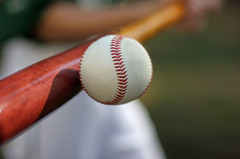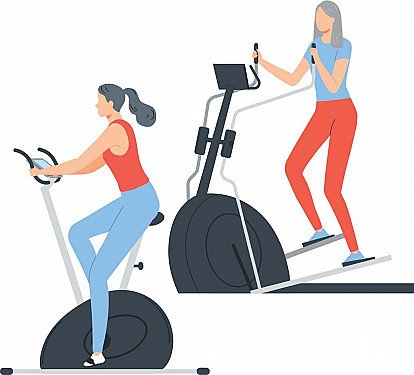Play Ball: Will new rules for bats make baseball safer?

Today is Opening Day, the first day of the 2011 major league baseball season. The first pitch was thrown a little after 1 p.m., and sometime after that baseball fans heard the first crack of the bat of a brand-new season.
Even nonfans can rejoice at this sign of spring, and a promise that summer days are ahead.
But you won’t hear the crack of the bat very much these days from other diamonds—Little League, high school, and college. It has been replaced by pings and thunks as most players at those levels now use metal bats or composite ones, which that are made with a mixture of materials, including graphite.
Players started using metal (usually aluminum) bats about 30 years ago. They last longer than wooden bats and send the ball farther. The composite models have come on strong more recently.
But there’s growing concern that nonwood bats may pose a safety hazard to fielders—especially pitchers— because they make a hit baseball go faster. The added speed gives fielders less time to react and, if they are hit, increases their risk of injury.
The organization that runs Little League decided late last year to put a moratorium on the use of composite bats. New rules in effect this year for college baseball are intended to simplify the standards and make nonwood bats perform more like wood ones. The same standards are scheduled to go into effect next season for high school baseball. (Safety isn’t the only reason: college baseball officials also want to rein in inflated batting averages and home run totals).
Batted balls can injure—and worse
When a baseball batter with a good, hard swing makes contact, the ball can leave the bat going 100 miles per hour or more—and that’s with a wood bat. It’s amazing, really, that people don’t get hurt more often. This spring, Luis Salazar, a minor league manager for the Atlanta Braves, lost an eye after he was hit by a foul ball. And four years ago, a minor league first-base coach, Mike Coolbaugh, was killed when he was hit in the head by a line drive. After Coolbaugh’s death, the rules were changed so first- and third-base coaches in the minor and major leagues are now required to wear helmets.
It takes just a few minutes (actually, more like seconds) of Web searching to find several reports of high school players getting seriously hurt by batted balls. The case that has attracted the most attention is 18-year-old Brandon Patch, who was pitching in an American Legion game (American Legion is a summer league for high school players) in Montana in 2003 when he was struck in the head and killed by a batted ball. His parents have campaigned for a ban on metal bats and have sued the bat manufacturer.
Some systematic research has also been done. Several years ago, researchers at the Center for Injury Research and Policy at Nationwide Children’s Hospital in Columbus, Ohio, collected reports of baseball-related injuries for the 2006 and 2007 seasons from a representative sample of 100 high schools. About 12% of the reported injuries (50 of 431) were from batted balls and half of them were to the head or face. The results were published in the journal Pediatrics.
I spoke with one of the Center’s researchers, Christy Collins, and she generously e-mailed me some additional data from Center’s the 100-school sample.
Overall, high school baseball is safe relative to other sports. Compared with eight other high school sports, it had the lowest injury rate during the 2009-2010 school year, according to the statistics Collins shared with me. (Not surprisingly, boys’ football had, by far, the highest injury rate).
Collins ran the numbers for baseball for the past five years from the high school sample, and the percentage of injuries from batted balls hovered around 10% of the total number of injuries (the same is true for girls’ softball). Pitchers (24.7%), third basemen (14%) and second baseman (11.8%) were the players most likely to be injured by a batted ball.
But the injury data that Collins and her coworkers have collected can’t be used to make comparisons between wood and nonwood bats because so few wood bats are used in high school.
Banning nonwood bats
One way to cut down on the number of batted-ball injuries would be to protect the most vulnerable fielders from the balls coming their way. Collins and the coauthor of the Pediatrics paper, R. Dawn Comstock, recommended they wear helmets, face shields, and mouth guards. I could see mouth guards, especially for pitchers. But helmet and face shields? Don’t see that happening.
Rule changes for bats are more acceptable. One possibility: just ban nonwood bats. North Dakota and New York City have done so. Legislators in California and New Jersey introduced bills that would impose nonwood bans after high school pitchers in their states were seriously hurt by a batted ball.
The new bat performance standards that went into effect this year for college baseball and will go into effect next year in high school are an attempt to have the best of both worlds: the durability of nonwood and the performance (and safety) of wood.
Controlling the trampoline effect
Two warnings. Read no further if high school physics brings back bad memories. And it’s far beyond the scope of this post (and the hastily acquired knowledge of its author) to explain all the wonderful intricacies of the physics of a bat hitting a ball.
The new performance standard for nonwood bats is called the BBCOR standard. BBCOR stands for ball-bat coefficient of restitution. It’s replacing the BESR (ball exit speed ratio) standard.
Alan M. Nathan, a professor of physics at University of Illinois, has written a lucid explanation of BBCOR and baseball bat performance. The Washington State University Sports Science Laboratory in Pullman, Washington, is in charge of certifying that bats meet the BBCOR performance standard, and you’ll find a helpful, but fairly technical, explanation in the glossary section of the lab’s Web site. And if you happen to be shopping for a bat, the Washington State lab has a list of BBCOR certified bats.
I spoke with Lloyd Smith, the lab’s director, and he was kind enough to give me a quick tutorial. Here’s my understanding of some of the physics involved:
Wood bats are solid. When a batter hits a baseball with a wood bat, the bat caves in just a little (about an eighth of inch), but the ball caves in a lot (almost an inch). (Watch it happen.) For the millisecond that a baseball and bat are in contact, the ball almost wraps around the bat. A lot of energy of the bat-ball collision is lost to deforming the baseball. Certainly the speed of the pitch helps, but David Ortiz, Albert Pujols, and other major leaguers need to swing their wood bats hard to hit line drives into the outfield or launch home runs into the bleachers.
Metal and composite bats are not solid. They’re hollow tubes. So when a baseball collides with a metal or composite bat, the wall of the bat gives quite a bit. You might think a “soft” bat would be counterproductive, but it’s not. Because the wall of the bat gives, the baseball doesn’t deform as much, so more of the energy of the bat-on-ball collision gets transferred to the “bounce” of the ball off the bat and less is consumed by the bat squishing the baseball.
The physics of the hollow metal and composite bats is called the trampoline effect, and the BBCOR standard is supposed to make it equal for all bats, metal and composite. Alan Nathan, the Illinois physics professor, describes BBCOR as a measure of the bounciness of the bats.
An additional issue with composite bats is that their trampoline effect increases after they get broken in. Players started hitting composite bats against trees or running them over with a car to maximize the trampoline effect as soon as possible. So, in addition to BBCOR tests, there are also “accelerated break-in” rules for composite bats.
Some mph comparisons
Smith ran some numbers through a formula for me that make easy comparisons between wood and nonwood bats possible. They are predicated on the ball traveling 70 mph when it hits the bat (that’s fairly slow by major league standards) and the batter swinging the bat so it’s also traveling at 70 mph (which is a good speed, even for a major leaguer). Other assumptions: the bat is 34 inches long and the meaty, barrel end of it is a realistic size.
Under such conditions, a baseball will travel 92.3 mph as it comes off a wood bat, 95.6 mph as it comes off a bat meeting the new BBCOR standards, and 100.7 mph as it comes off a bat meeting the old BESR standards, according to Smith’s calculations. So the new BBCOR bats are in the middle in terms of batted ball speed and not quite the same as wood. But Smith said that if the very best wood bats are used, the gap between the wood and the BBCOR bats would close and wind up being very small.
Smith also stressed that in reality, the speed of a batter’s swing is going to have more influence on the speed of a batted ball than the makeup of the bat.
About the Author

Peter Wehrwein, Contributor, Harvard Health
Disclaimer:
As a service to our readers, Harvard Health Publishing provides access to our library of archived content. Please note the date of last review or update on all articles.
No content on this site, regardless of date, should ever be used as a substitute for direct medical advice from your doctor or other qualified clinician.















